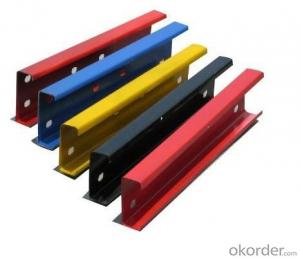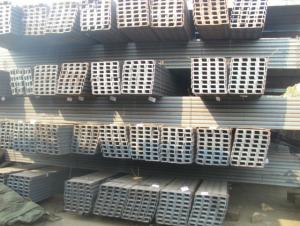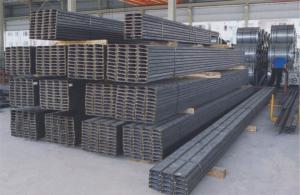MS Steel C Channel
- Loading Port:
- Tianjin Port, China
- Payment Terms:
- TT or LC
- Min Order Qty:
- 10Tons m.t.
- Supply Capability:
- 500 Tons Per Month m.t./month
OKorder Service Pledge
OKorder Financial Service
You Might Also Like
Specifications of MS Steel C Channel:
1. We are definitely speciallizing in manufacturing and supplying channel steel as per japanese standard, which is characterised with high mechanical strength and competitive prices.
2. The sections in details are as followings in the table-1
Size | Weight(kg/m) | Size | Weight(kg/m) |
80×40×20×2.5 | 3.925 | 180×60×20×3 | 8.007 |
80×40×20×3 | 4.71 | 180×70×20×2.5 | 7.065 |
100×50×20×2.5 | 4.71 | 180×70×20×3 | 8.478 |
100×50×20×3 | 5.652 | 200×50×20×2.5 | 6.673 |
120×50×20×2.5 | 5.103 | 200×50×20×3 | 8.007 |
120×50×20×3 | 6.123 | 200×60×20×2.5 | 7.065 |
120×60×20×2.5 | 5.495 | 200×60×20×3 | 8.478 |
120×60×20×3 | 6.594 | 200×70×20×2.5 | 7.458 |
120×70×20×2.5 | 5.888 | 200×70×20×3 | 8.949 |
120×70×20×3 | 7.065 | 220×60×20×2.5 | 7.4567 |
140×50×20×2.5 | 5.495 | 220×60×20×3 | 8.949 |
140×50×20×3 | 6.594 | 220×70×20×2.5 | 7.85 |
160×50×20×2.5 | 5.888 | 220×70×20×3 | 9.42 |
160×50×20×3 | 7.065 | 250×75×20×2.5 | 8.634 |
160×60×20×2.5 | 6.28 | 250×75×20×3 | 10.362 |
160×60×20×3 | 7.536 | 280×80×20×2.5 | 9.42 |
160×70×20×2.5 | 6.673 | 280×80×20×3 | 11.304 |
160×70×20×3 | 8.007 | 300×80×20×2.5 | 9.813 |
180×50×20×2.5 | 6.28 | 300×80×20×3 | 11.775 |
180×50×20×3 | 7.536 | ||
180×60×20×2.5 | 6.673 |
Table-1
3. The mechanical property of MS Steel C Channel in the table-2:
Grade | Yield Strength,N/mm² | Extension Strength N/mm² | |||
Thickness of Steel,mm | |||||
≦16 | >16-≦40 | >40-≦100 | >100 | ||
SS330 | ≧205 | ≧195 | ≧175 | ≧165 | 330-430 |
SS400 | ≧245 | ≧235 | ≧215 | ≧205 | 400-510 |
SS490 | ≧285 | ≧275 | ≧255 | ≧245 | 490-610 |
SS540 | ≧400 | ≧390 | - | - | ≧540 |
Table-2
4. The chemical composition of MS Steel C Channel in the table-3
Grade | Element(%) | |||
C | Mn | P | S | |
SS330 | -- | -- | ≦0.050 | ≦0.050 |
SS400 | ||||
SS490 | ||||
SS540 | ≦0.30 | ≦1.60 | ≦0.040 | ≦0.040 |
Table-3
Usage of MS Steel C Channel:
1.The MS Steel C Channel can be devided into two kinds, namely common channel steel and light channel steel. The sizes of hot rolled common channel steel range from 5# to 40#. Meanwhile, the channel steel can be divided into cold forming sectional equal channel steel, cold forming sectional unequal channel steel, cold forming inner edge channel steel and outer edge channel steel.
2.The MS Steel C Channel is usually used for arch-itechtural structure, and they could be welded in order to support or hang a vari-ety of facilities. They are also usually used in combination with I beam. The channel steel with sizes under 14# is usually applied to construction engineering, as purline, while the channel steel with sizes above 16# is more likely to be used in building vehicle chassis structure and mechanical structure. Furthermore, the channel steel in sizes above 30# are target at building bridge structure, as tension bar.
3.In a word, the channel steel must possess perfect welding property, riveting property and mechanical property and so on.
Package & Delivery of MS Steel C Channel:
1.The MS Steel C Channel will be packed in bundle with steel wire at each end of every bundle and color marking in order to help the customer to recognize his goods more easily at sight.
2. And the MS Steel C Channel could be loaded into 20ft or 40ft container, or by bulk cargo.If the weight of each bundle reaches more than 3.5 mt, the loading by break bulk cargo should be choosed.When the weight of each bundle reaches less than 3mt, the loading by container should be choosed.
3.As for the transportaion from mill to loading port, the truck will be usually used. And the maximum quantity for each truck is 40mt.
4.All in all, we could do in accordance with customer's request.

Production Flow of MS Steel C Channel:
1.The steel billet shall be heated in the high temperature furnace.
2. The heated steel billet shall be rolled five to nine times with the aim of shaping the general figure of steel u channel.
3. The rolled steel channel should be put onto the cooling bed to make the temperature low.
4. The MS Steel C Channel should be straighted on the straightener.
5. The straighted steel u channel will be cut into meters by saw, as per customer's requirements.
6. At the last part of production, the channel steel must be tested in order to confirm that the finished products are completely free from crack, pore, slag, scab or fold on the surface.

- Q: Can steel channels be used for overhead crane systems?
- Yes, steel channels can be used for overhead crane systems. Steel channels provide the necessary strength and stability required for supporting the weight and movement of overhead cranes, making them a suitable choice for such systems.
- Q: Are steel channels suitable for heavy machinery installations?
- Yes, steel channels are suitable for heavy machinery installations. Steel channels provide strong structural support, high load-bearing capacity, and durability, making them ideal for handling heavy machinery installations and ensuring stability and safety.
- Q: What are the different types of steel channel connections for door frames?
- There are several types of steel channel connections commonly used for door frames, including welded connections, bolted connections, and bracket connections. Welded connections involve welding the steel channel directly to the door frame, providing a strong and permanent connection. Bolted connections use bolts and nuts to secure the steel channel to the door frame, allowing for easy disassembly and reassembly if needed. Bracket connections utilize brackets that are attached to both the steel channel and the door frame, providing a secure and adjustable connection. Each type of connection has its advantages and is chosen based on the specific requirements and preferences of the project.
- Q: Can steel channels be used for cable management?
- Yes, steel channels can be used for cable management. Steel channels are often used in industrial and commercial settings to organize and protect cables. They provide a durable and secure solution for managing cables by keeping them organized, preventing them from being damaged or tangled, and allowing for easy access and maintenance. Steel channels can be mounted on walls or ceilings and can accommodate various types and sizes of cables. They are particularly useful in environments where there is a need for heavy-duty cable management, such as data centers, manufacturing facilities, and construction sites.
- Q: How do steel channels compare to other structural shapes?
- Steel channels are a versatile and widely-used structural shape that offer various advantages when compared to other structural shapes. One of the key benefits of steel channels is their high strength-to-weight ratio. Due to their shape, steel channels provide excellent support and load-bearing capacity, allowing for the construction of robust and durable structures. Compared to other structural shapes such as I-beams or angles, steel channels have a distinct C-shaped cross-section, which offers greater resistance to bending. This makes them particularly suitable for applications where torsional or bending forces are present, ensuring structural integrity and stability. Additionally, steel channels have a wide range of sizes and configurations available, making them highly adaptable to different construction requirements. They can be easily customized and cut to specific lengths, allowing for precise installation and reducing wastage. This versatility makes steel channels a popular choice in various industries, including construction, manufacturing, and engineering. Another advantage of steel channels is their cost-effectiveness. Steel is a relatively affordable material, and the efficient use of steel channels in construction projects can help optimize costs without compromising on structural integrity. Moreover, steel channels have excellent corrosion resistance properties, extending their lifespan and reducing maintenance and replacement expenses. In summary, steel channels offer numerous advantages compared to other structural shapes. Their high strength-to-weight ratio, resistance to bending, adaptability, and cost-effectiveness make them a reliable choice for a wide range of construction applications.
- Q: Can steel channels be recycled?
- Yes, steel channels can be recycled. Steel is a highly recyclable material, and steel channels can be melted down and reprocessed to create new steel products without losing their structural integrity. Recycling steel channels helps conserve resources, reduce energy consumption, and minimize waste.
- Q: Can steel channels be used in the construction of elevated walkways?
- Yes, steel channels can be used in the construction of elevated walkways. Steel channels, also known as C-channels, are commonly used in construction due to their strength and durability. They are suitable for supporting heavy loads and can be designed to provide the necessary structural integrity for elevated walkways. Steel channels offer excellent resistance to bending and twisting forces, making them ideal for creating stable and secure walkways at heights. Additionally, steel channels can be easily fabricated and installed, allowing for efficient construction of elevated walkways. Overall, steel channels are a reliable and popular choice for the construction of elevated walkways.
- Q: Can steel channels be used for column and beam connections?
- Yes, steel channels can be used for column and beam connections. Steel channels are often used as structural components in construction projects due to their strength and durability. They can be welded, bolted, or connected using other methods to create secure connections between columns and beams.
- Q: What are the common maintenance practices for steel channels?
- Common maintenance practices for steel channels include regular cleaning to remove dirt, dust, and debris, as well as inspecting for corrosion or rust. Applying protective coatings or paint can help prevent oxidation and maintain the appearance of the channels. Regular lubrication of moving parts, such as hinges or mechanisms, is also important to ensure smooth operation. Additionally, checking for any structural damage, such as cracks or bends, and promptly repairing or replacing any damaged sections is crucial to maintain the integrity and safety of the steel channels.
- Q: Can steel channels be used in the construction of solar panel mounting structures?
- Yes, steel channels can be used in the construction of solar panel mounting structures. Steel channels provide strong support and stability, making them suitable for holding the weight of solar panels and withstanding various environmental conditions.
1. Manufacturer Overview
| Location | Tianjin, China |
| Year Established | 2007 |
| Annual Output Value | Above US$ 15 Million |
| Main Markets | Southeast Asia; Africa |
| Company Certifications |
2. Manufacturer Certificates
| a) Certification Name | |
| Range | |
| Reference | |
| Validity Period |
3. Manufacturer Capability
| a) Trade Capacity | |
| Nearest Port | Tianjin |
| Export Percentage | 15%-20% |
| No.of Employees in Trade Department | 11-20 People |
| Language Spoken: | English; Chinese; |
| b) Factory Information | |
| Factory Size: | Above 6,500 square meters |
| No. of Production Lines | 1 |
| Contract Manufacturing | OEM service offered |
| Product Price Range | average |
Send your message to us
MS Steel C Channel
- Loading Port:
- Tianjin Port, China
- Payment Terms:
- TT or LC
- Min Order Qty:
- 10Tons m.t.
- Supply Capability:
- 500 Tons Per Month m.t./month
OKorder Service Pledge
OKorder Financial Service
Similar products
Hot products
Hot Searches
Related keywords






























